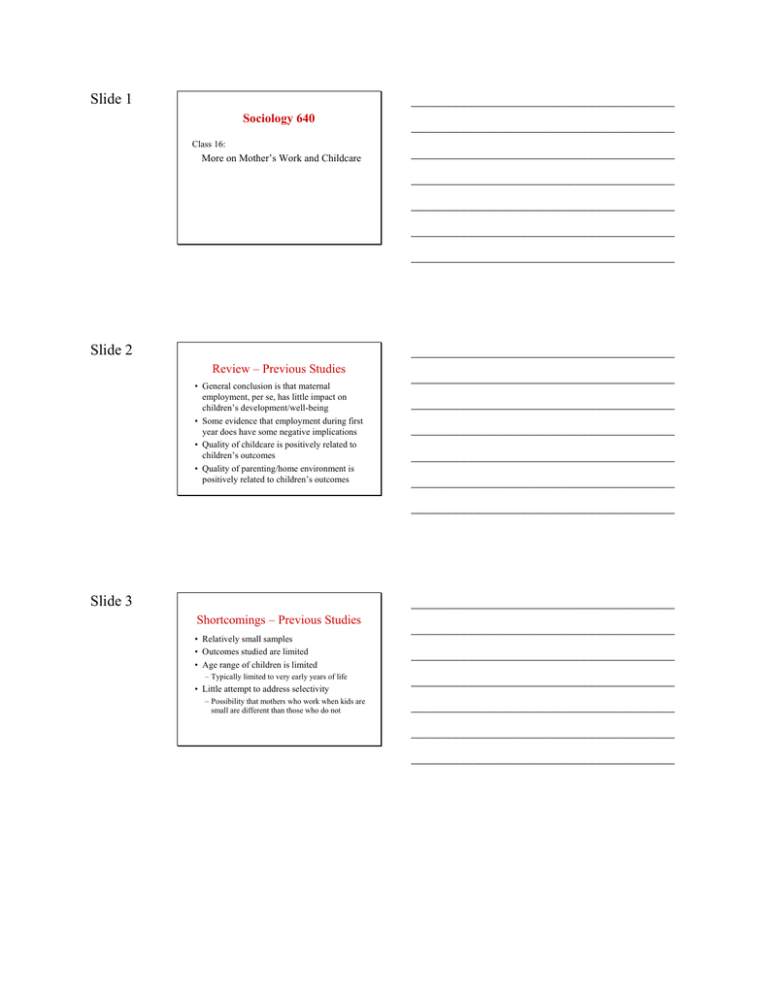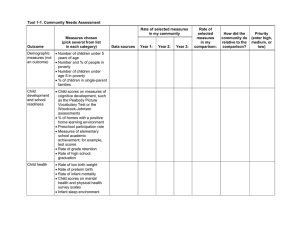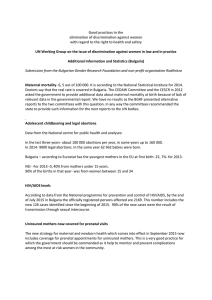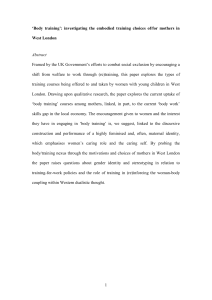Slide 1 ___________________________________
advertisement

Slide 1 ___________________________________ Sociology 640 Class 16: More on Mother’s Work and Childcare ___________________________________ ___________________________________ ___________________________________ ___________________________________ ___________________________________ ___________________________________ Slide 2 ___________________________________ Review – Previous Studies • General conclusion is that maternal employment, per se, has little impact on children’s development/well-being • Some evidence that employment during first year does have some negative implications • Quality of childcare is positively related to children’s outcomes • Quality of parenting/home environment is positively related to children’s outcomes ___________________________________ ___________________________________ ___________________________________ ___________________________________ ___________________________________ ___________________________________ Slide 3 ___________________________________ Shortcomings – Previous Studies • Relatively small samples • Outcomes studied are limited • Age range of children is limited – Typically limited to very early years of life • Little attempt to address selectivity – Possibility that mothers who work when kids are small are different than those who do not ___________________________________ ___________________________________ ___________________________________ ___________________________________ ___________________________________ ___________________________________ Slide 4 ___________________________________ Study based on Large Longitudinal Study – NLSY79 • Follow-up large sample of M&W age 15-22 in 1979 • Observe transition to parenthood, work patterns, home environment, and children’s cognitive development • Mothers’/Fathers’ employment in first 3 years of children’s lives • Vocabulary, Reading, Math (3-6 year olds) • Relevance of these measures as predictors of longer-term outcomes ___________________________________ ___________________________________ ___________________________________ ___________________________________ ___________________________________ ___________________________________ Slide 5 Differences in Cognitive Development – Bivariate Relationships ___________________________________ ___________________________________ 108 ___________________________________ 107 PIAT-R Test 106 105 ___________________________________ 104 103 ___________________________________ 102 101 Year 1 Years 2-3 Mother’s Weekly Work Hrs. 0 1 to 29 30+ ___________________________________ ___________________________________ Slide 6 Mother’s work status and socioeconomic profile 35 30 ___________________________________ ___________________________________ ___________________________________ 25 20 ___________________________________ 15 10 ___________________________________ 5 0 Age at birth Education Mother’s Weekly Work Hrs. 0 Fam. Poverty 1 to 29 30+ Low Birth Weight ___________________________________ ___________________________________ Slide 7 ___________________________________ General Results • Positive bivariate relationship disappears when maternal characteristics are controlled • A negative effect of employment at age 1 on M&R scores at age 5-6 • Even bigger negative effect of employment at ages 2-3 on M&R scores at age 5-6 • Offset somewhat by father’s employment • Implications for single mothers with limited economic resources? • Weaknesses of this study: very limited measures of parental involvement/home environment, no good measures of childcare quality ___________________________________ ___________________________________ ___________________________________ ___________________________________ ___________________________________ ___________________________________ Slide 8 ___________________________________ Another Recent Study • Similar focus • Much greater detail on home environment, parenting quality, and childcare quality • Measure cognitive development & school readiness at 2 yrs. and 3 yrs. • Focuses on maternal employment in the first year ___________________________________ ___________________________________ ___________________________________ ___________________________________ ___________________________________ ___________________________________ Slide 9 ___________________________________ General Findings • School readiness at age 3 lower for children whose mothers worked in first year of life • Especially low for children of working mothers with lower parenting sensitivity • Especially low for sons of working mothers • Especially low for children of working mothers who are married ___________________________________ ___________________________________ ___________________________________ ___________________________________ ___________________________________ ___________________________________ Slide 10 School Readiness at Age 3 – Effects of Maternal Employment 55 ___________________________________ ___________________________________ School-Readiness at age 3 50 ___________________________________ 45 40 ___________________________________ 35 30 ___________________________________ 25 1 2 3 4 5 6 7 8 1: Avg. characteristics, mother not working 5: Same as 3 – but low maternal sensitivity 2: Same as 1 – but mother working <30 hrs/week 6: Same as 3 – but below avg. childcare 3: Same as 1 – but mother working>=30 hrs./week. 7: Same as 1 – but better environ., sensitivity, childcare 4: Same as 3 – but worse home environment 8: Same as 3 – but worse environ, sensitivity, chilcare ___________________________________ ___________________________________ Slide 11 Perry Preschool Program ___________________________________ ___________________________________ 123 Low SES 3-4 Year Olds High Quality Preschool Program n=58 High Quality Preschool Program n=65 ___________________________________ ___________________________________ ___________________________________ Subsequent Outcomes vs. Subsequent Outcomes ___________________________________ ___________________________________ Slide 12 ___________________________________ Outcomes • • • • HS graduation: 71% vs. 54% $2k+ per month at 27: 29% vs. 7% Own home at 27: 36% vs. 13% Mean # arrests by 27: 2.3 vs. 4.6 ___________________________________ ___________________________________ ___________________________________ ___________________________________ ___________________________________ ___________________________________






